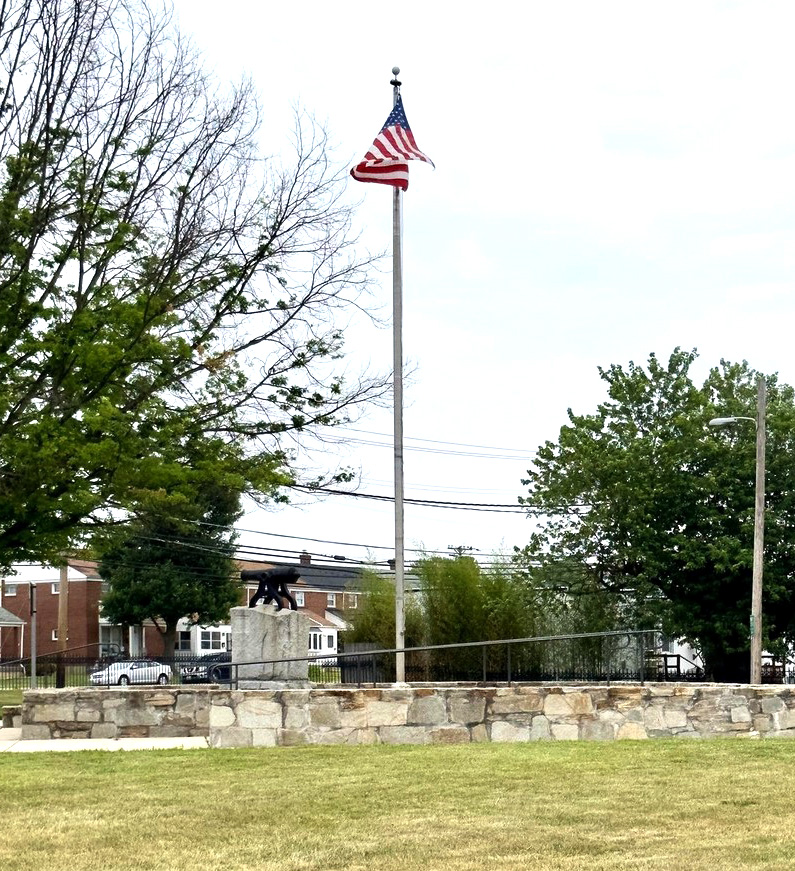
Bear Creek Historical Project
A Study of the Land and Its People
THE REMEMBRANCE OF THINGS PAST
In the years following the British invasion, veterans and local citizens chose to remember the sacrifices made during the Battle of Patapsco Neck in various ways. Monuments were erected, commemorations enacted, and, more recently, living history programs involving both civilian and military re-enactors. Years after the battle, on July 21, 1817, US President John Quincy Adams visited Patapsco Neck to honor those who had fallen during the battle. The monuments and historic sites themselves are their own story.

AQUILA RANDALL MONUMENT
At the intersection of Old North Point Road and Old Battle Grove Road stands the second oldest military monument in Maryland and the third oldest in the United States. It is one of Maryland’s least visited War of 1812 sites – the Aquila Randall Monument – and is dedicated to honor Private Aquila Randall, who was killed in a skirmish just before the Battle of North Point on September 12, 1814.
On July 21, 1817, soldiers mustered in Baltimore and marched six miles to the North Point battleground. Accompanying them was President John Quincy Adams, who remarked, “The distance is about nine miles from the town, over a barren country, covered great part of the way with forest-trees, now undressing for the winter.” Accompanying them were wagons conveying the monument blocks to be assembled and dedicated on site that day.



BATTLE ACRE
For the first twenty-five years after the Battle of North Point, most “September 12th” commemorations were held in Baltimore. On July 8, 1839, delegates from several militia companies who had fought at Patapsco Neck held a “Military Convention” at Baltimore’s City Hall. Representatives at the conference approved a newspaper ad asking for designs and cost estimates for placing a monument on the battleground.
A few weeks later, on September 11, 1839, local Baltimore businessman Jacob Houck donated an acre of land to the State of Maryland to be used as a site for the intended monument. That land became known as “Battle Acre.”
On the following day, September 12, 1839, the 25th Anniversary of the Battle of Patapsco Neck, a cornerstone ceremony was held at Battle Acre. The cornerstone was to serve as the foundation for the monument honoring those who had fought there. The ceremony was well attended by city and national officials including Supreme Court Justices and Cabinet officers. However, nothing came of the grand ceremony.
Battle Acre fell on hard times over succeeding decades.
By 1914, Mrs. Reuben Ross Holloway, granddaughter of Jacob Houck, succeeded in getting the Star-Spangled Banner Commission to perform some restoration work at the site. The work included erecting a large granite memorial stone at its center that was mounted with a small cannon from the War of 1812. A plaque was placed on the stone and a wrought iron fence installed around the acre.



PERIODIC IMROVEMENTS OF THE BATTLEGROUND
Nearly 200 years after the battle, concerned local residents formed a committee to maintain and improve the Battle Acre site. In 2004, the Society for the War of 1812 in Maryland dedicated a new plaque. In 2005, a temporary repair of the Battle Acre flagpole and its lighting allowed the US flag to permanently fly over the park. Since then, the County has improved pedestrian access to the site, repaired and painted the wrought iron fence, and renovated six granite pillars. When the two wrought iron entry gates were stolen and destroyed in 2014, they were replaced through a donation by local resident Ed Hale of Dundalk. Since 2009, Battle Acre has been kept clean of trash and rubbish through the ongoing efforts of the non-profit organization Clean Bread and Cheese Creek under the leadership of local resident John Long.



METHODIST MEETING HOUSE PROPERTY
The former Methodist Meeting House that stood near Bread and Cheese Creek was witness to all phases of the Battle of North Point. On September 11, 1814, a day prior to the battle, it was used by US forces as a muster point and field headquarters. On September 12, 1814, the day of the battle, it was used as a headquarters and field hospital by both sides dependent on which side controlled the field of battle. On September 13, 1814, the day after the battle, it served as a field hospital and its grounds as a morgue. In 1914, during the Star-Spangled Banner Centennial, the Patriotic Order, Sons of America, placed a granite monument and iron fence on the grounds and cemetery of the Patapsco Neck Battle Ground Meeting House.